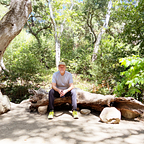When Did You Stop Dancing?
A friend of mine from West Africa told me an interesting story many years ago. When someone was brought to the local healer with an ailment, the sick person was sometimes asked by the healer, “When did you stop dancing?”
At first, I laughed. But as I contemplated the healer’s response, I sensed the profundity of this question — it was a clear example of exploring the causes, rather than prescribing something for the effects.
In my friend’s culture, dancing was such a common and natural activity. So, when someone stopped, it was alarming enough to warrant a search for the cause. The hope was that by identifying “when” someone switched from doing a joyous, fun, and natural activity, to NOT doing it, the healer could help the patient understand and heal the root of their ailment.
I should note, the “when” part of it was not just “what time”, but also “under what circumstances”.
So, lately, I’ve been asking myself this question. Have I stopped dancing? If I am still dancing, what’s keeping my feet tapping? And is this dancing the very thing that’s helped me navigate the muddy waters of the last couple of years?
Why Am I Questioning My Dance Now?
I guess this whole question started as part of a conversation I was having with a friend a few months ago. We were just starting to come out of Covid (for me, that means having been fully vaccinated, with my booster on top). And we asked each other: How are we emerging from this experience? Ill (either literally or figuratively)? Whole? Fractured? Changed? Renewed? Much the same? (Or in the words of David Byrne, “same as it ever was”).
As many of my readers well know, this general topic was also the subject of my recent Covid Triptych series — exploring what effects Covid might’ve had on us individually, as well as societally.
But now, I stand post-triptych, and I wonder…might I be able to detect any latent “illness” if I considered things from the perspective of the dancer (per the healer’s suggestion)?
The Way My Former Self Danced
As I consider the question of am I still dancing, and if so, how? I think to myself, “I still feel pretty good — I really believe that I am happy”. So, for starters, I do believe I am still dancing. But it’s something that’s changed over time.
Let’s just say I’ve lived a structured life. I am proud of my efficiency and organization, which have both led to what I believe to have been an accomplished life.
In the past, my structure consisted partly of a laundry list of things I thought I had to do, places I needed to go, people I wanted to meet. So, for my former self, I would akin my dance to that of a two-step. For us Texans, even if we are not the “traditional” Texan (you know, the ones who wear cowboy boots and hats and listen to country music all the time), most of us still enjoy going to dance halls to listen and dance to the good stuff, like my own favorite, Joe Ely. And to me, country music dancing appears very structured. The rhythms of most of the songs played fit neatly into several prescribed categories, such as a waltz, two-step, and even a polka. It’s a type of dancing that’s drenched in tradition, scripted steps. You find enjoyment in the fact that you know how to do it and do it well.
(To get a sense of the atmosphere of these honky-tonks, the music, the storytelling, and the rambunctious atmosphere, listen to Joe Ely’s, “West Texas Waltz” here.)
How I Dance Now
But like many men of a certain age, I don’t really dance; not so much; not anymore. At least not literally. And when I do, it feels kind of, well, awkward.
However, in recent times, I have worked hard to distill my work and my days to chase less “have-to’s” and more “want-to’s”.
Want-to’s feel more like soul work. This means fewer laundry lists and more observational discernment — usually beginning with the question, “what makes me really happy?” It’s also more about going with the flow. Easier said than done for someone like me, fixated on “making it happen”, rather than allowing it to, well, flow. Everything looks like a raging river, for a man with a paddle.
But that’s why much of my dancing these days feels more akin to that of the 1960s flower child. Like in Woodstock, they danced and swayed, rhythmically swirling to psychedelic hippie music ( no doubt, “influenced”, moving beyond mere dance steps). They were going higher, literally and figuratively. Their aim was personal “interpretation”, inspired by something beyond them. No script, just people, together, entranced. So magical.
Why It Matters to Do a “Dance Check”
Looking back on things thus far, I think I can confidently say that I’ve never stopped dancing. I might have changed up my tunes, my steps, the rhythm, and the tempo. But my boogie has always stayed.
And thinking back on my conversation with my friend from a few months back about our paths through Covid, I think the reason I’ve been able to “come out on the other side” (so to speak) is honestly because I never stopped dancing. True, the dancing I used to do in my younger days and the shuffles and spins I do now are so different.
But all dancing is good, as long as you dance — and if you can keep up the tempo, any storm can seem just like a little afternoon drizzle.
Curious about other writings of mine? You can find all my thoughts, musings, and words of “wisdom” on my website. https://www.stringtheorybyraybrimble.com/
